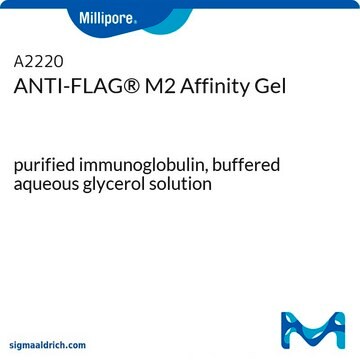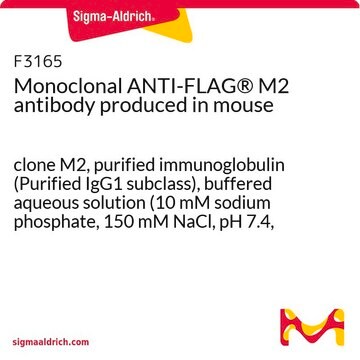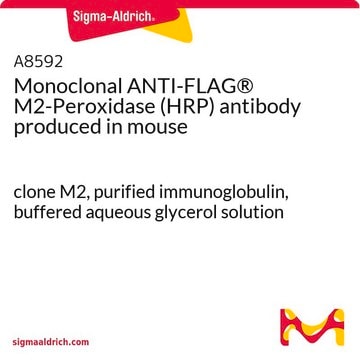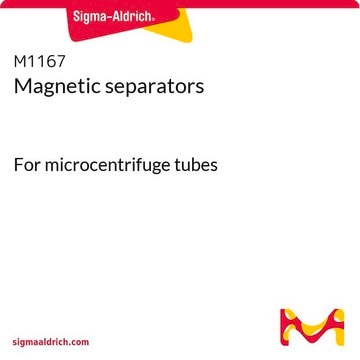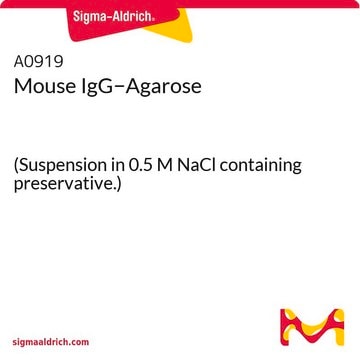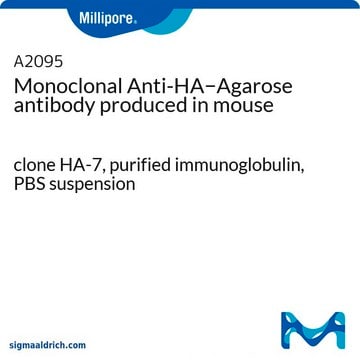The antibody used for these items is proprietary information. ANTI-FLAG M2 Magnetic Beads consist of a mouse-derived, ANTI-FLAG M2 monoclonal antibody attached to superparamagnetic iron-impregnated 4% agarose beads. EZview Red ANTI-FLAG M2 Affinity Gel contains ANTI-FLAG M2 monoclonal antibody covalently attached to cross-linked 4% agarose beads. The ANTI-FLAG M2 antibody recognizes the FLAG octapeptide sequence (N-Asp-Tyr-Lys-Asp-Asp-Asp-Asp-Lys-C) at the N-terminus, Met-N-terminus, or C-terminus locations of a fusion protein.
M8823
Anti-FLAG® M2 Magnetic Beads
affinity isolated antibody
Synonym(s):
Monoclonal ANTI-FLAG® M2 antibody produced in mouse, FLAG® magnetic affinity resin, FLAG® resin for high throughput, Flag® Affinity resin, Anti-ddddk, Anti-dykddddk
Select a Size
About This Item
affinity chromatography
immunoprecipitation (IP): suitable
Recommended Products
conjugate
magnetic beads
Quality Level
antibody form
affinity isolated antibody
antibody product type
primary antibodies
clone
M2, monoclonal
form
suspension
shelf life
2 yr at -20 °C
analyte chemical class(es)
proteins
technique(s)
affinity chromatography: suitable
immunoprecipitation (IP): suitable
bead size
20-75 μm
matrix
superparamagnetic iron impregnated 4% agarose bead, with an average diameter of 50 μm.
isotype
IgG1
capacity
≥0.6 mg/mL binding capacity
shipped in
wet ice
storage temp.
−20°C
Looking for similar products? Visit Product Comparison Guide
General description
Application
Elution - FLAG® peptide, Glycine, pH 3.5, 3x FLAG® peptide
Learn more product details in our FLAG® application portal.
Features and Benefits
- Very rapid separation
- Significantly accelerated manipulations, such as repetitive washings
- Processing of multiple samples performed in plate formats
This leads to:
- Faster experimentation
- Better reproducibility
- More accurate quantitation of the proteins of interest
Physical form
Legal Information
Disclaimer
Not finding the right product?
Try our Product Selector Tool.
related product
Storage Class Code
12 - Non Combustible Liquids
WGK
WGK 1
Flash Point(F)
Not applicable
Flash Point(C)
Not applicable
Personal Protective Equipment
Choose from one of the most recent versions:
Certificates of Analysis (COA)
Don't see the Right Version?
If you require a particular version, you can look up a specific certificate by the Lot or Batch number.
Already Own This Product?
Find documentation for the products that you have recently purchased in the Document Library.
Customers Also Viewed
Articles
The FLAG® Expression System is a proven method to express, purify and detect recombinant fusion proteins. Sigma®, the proven provider of FLAG®, now offers a magnetic bead for immunoprecipitation, protein purification, and the study of protein-protein interactions. The ANTI-FLAG® M2 Magnetic Bead is composed of murine derived, anti-FLAG® M2 monoclonal antibody attached to superparamagnetic iron impregated 4% agarose beads, with an average diameter of 50 µm. The M2 antibody is capable of binding to fusion proteins containing a FLAG peptide sequence at the N-terminus, Met-N-terminus, or C-terminus locations in mammalian, bacterial, and plant extracts.
Comparison of elution techniques for small-scale protein purification of FLAG® tag proteins using anti-FLAG® M2 magnetic beads.
Related Content
Protein purification techniques, reagents, and protocols for purifying recombinant proteins using methods including, ion-exchange, size-exclusion, and protein affinity chromatography.
Protein expression technologies for various expression systems supporting research, therapeutics, and vaccine production.
-
Which antibody is used to bind to the beads in Anti-FLAG® M2 Magnetic Beads(M8823) and EZview™ Red ANTI-FLAG® M2 Affinity Gel(F2426)? I have ordered the antibody(F1804 Monoclonal ANTI-FLAG® M2 antibody produced in mouse). Is it this one?
1 answer-
Helpful?
-
-
Hello, I want to ask how many Flag-antibody on those beads?
1 answer-
The specific number of antibodies per bead is not determined. The minimum amount of antibody in this product is 2.5 mg/mL of suspension. A range of 1.7 - 2.1 mL of suspension will yield 1 mL of packed resin. Both of these values are lot specific and reported in the Certificate of Analysis. Please see the link below to review a sample or lot specific Certificate:
https://www.sigmaaldrich.com/product/sigma/m8823#product-documentationHelpful?
-
-
What is the maximum number of times that the ANTI-FLAG® M2 Magnetic Beads (M8823) can be reused?
1 answer-
The maximum number of times that the ANTI-FLAG® M2 Magnetic Beads (M8823) can be reused varies depending on the specific sample applied. It can range from one to twenty uses. Factors such as the cleanliness of the sample and the presence of substances that may clog the resin or cause nonspecific binding can affect the number of reuses. In typical scenarios, the beads are commonly reused for 3-5 times. It is essential to refer to the technical bulletin for specific situations where the beads cannot be reused, such as when using reagents containing SDS: https://www.sigmaaldrich.com/deepweb/assets/sigmaaldrich/product/documents/187/075/m8823bul-ms.pdf
Helpful?
-
-
Are the M2 antibodies on the Anti-FLAG® M2 Magnetic Beads covalently bound?
1 answer-
The M2 Flag antibody is linked to the resin through a covalent linkage to one heavy chain. However, during the conjugation process, some Flag antibodies may also become bound to the resin through noncovalent attachments. To mitigate this, it is recommended to wash the resin using 0.1M Glycine followed by equilibration before using it. This washing step ensures that the noncovalently linked antibodies are washed off.
Helpful?
-
-
Is there a protocol available for using the Anti-Flag M2 Magnetic Beads in a ChIP-Seq assay? Additionally, if the lysis buffer contains SDS and sodium deoxycholate at a concentration of 0.1%, will the presence of both denature or interfere with binding in the research process?
1 answer-
The use of Anti-Flag M2 Magnetic Beads in a ChIP-Seq assay has not been validated. However, according to a citation provided in Stem Cells (PMID: 31348575), it suggests that these beads are compatible for such applications. Please note that M8823 is not recommended for use with Sodium Dodecyl Sulfate (SDS) or deoxycholate, as these components can denature the immobilized antibody and disrupt its binding to FLAG fusion proteins.
Helpful?
-
-
Is Product No. CL4B200, Sepharose® CL-4B a suitable alternative for a negative bead control if magnetic beads without FLAG are not available? Are there any other recommendations for this purpose?
1 answer-
For a negative control bead, any underivatized bead can essentially be used. While the Anti-FLAG® M2 Magnetic Beads (M8823) will work as a negative bead, it may not be suitable for magnetic applications. If a magnetic format is required, it is recommended to use polystyrene-based magnetized beads such as Product No. 49664, Micro particles based on polystyrene, magnetic. Alternatively, another option is to create a negative control using a non-FLAG tagged protein. This control can demonstrate the specificity of M8823 by showing its significant detection of FLAG-tagged proteins.
Helpful?
-
-
Does M8823 have the capability to detect internal FLAG tags in addition to N and C terminal sequences?
1 answer-
This paper (Zordan RE, Beliveau BJ, Trow JA, Craig NL, Cormack BP. Avoiding the ends: internal epitope tagging of proteins using transposon Tn7. Genetics. 2015 May;200(1):47-58. doi: 10.1534/genetics.114.169482. Epub 2015 Mar 5. PMID: 25745023; PMCID: PMC4423380) indicates that internal FLAG epiptopes were inserted into ORFs in yeast and detected by our F1804 antibody via Western blot. The biggest issue to overcome is the availability of the epitope for the antibody. If it is buried where it is not accessible in its native form, may not be possible. Denaturing the protein at least in this situation shows that the antibody can detect the protein.
Helpful?
-
-
Are there any problems with incubation at 40°C for this product?
1 answer-
The information you are requesting can be supplied by our Technical Service team who can assist you further. We kindly ask you to navigate to the link https://www.sigmaaldrich.com/techservice, and click on "Product Technical Inquires" under the Products Section with all the required information so that a member of our team can reach out to you to assist further. Thank you.
Helpful?
-
-
Dear all, I have a question regarding one of you product: Anti-FLAG® M2 Magnetic Beads, Cat. No: M8823. Is 0.1% SDS compatible with product binding FLAG peptide?
1 answer-
This product is not recommended for use with Sodium Dodecyl sulfate nor deoxycholate as they are known to denature the immobilized antibody and interfere with antibody binding to FLAG fusion protein.
Regarding reagent compatibility and protocol information, please see page 5 of the product technical bulletin at the link below:
https://www.sigmaaldrich.com/deepweb/assets/sigmaaldrich/product/documents/187/075/m8823bul-ms.pdfHelpful?
-
-
Is this bead’s compatible with TCEP reducing reagent?
1 answer-
It is recommended that no reducing agents be added. These agents will also reduce the disulfide linkages in the M2 antibody on the resin and destroy its ability to bind the FLAG fusion proteins.
Please see the link below, page 4, of the Product Data Sheet:
https://www.sigmaaldrich.com/deepweb/assets/sigmaaldrich/product/documents/187/075/m8823bul-ms.pdfHelpful?
-
Active Filters
Our team of scientists has experience in all areas of research including Life Science, Material Science, Chemical Synthesis, Chromatography, Analytical and many others.
Contact Technical Service